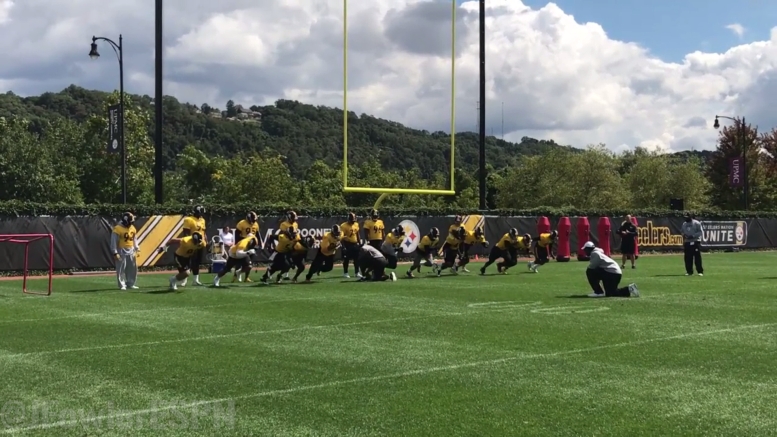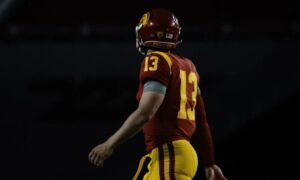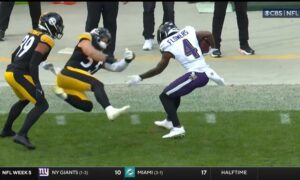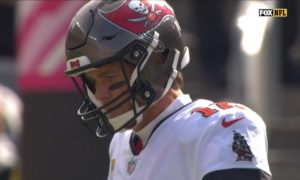As we’re all drumming our fingers while we wait for the return of the NFL, any move forward sounds promising. So on June 5th when coaching staff were allowed to return to training facilities, it looked like a step in the right direction. A mere 3 days later, Albert Breer tweeted all 6 pages of the NFL-NFLPA Club Facility Protocol for the 2020 Season published the prior day, detailing the safety policies teams would need to follow for players to return to team facilities, presumably for training camp. Sounded pretty exciting to think that the league had already established the steps to get the party started.
Not so fast, though. That same day, the NFLPA fired back, advising players that the union had not, in fact, approved this policy. And 2 days later, the NFL backtracked, releasing a memo stating that no date had been set for players to return to team facilities but confirming that minicamps wouldn’t be happening. The memo, also tweeted by Breer, announced that the “virtual period” would continue through June 26.
While there’s no final terms accepted by the NFLPA, we all know that both the league and the players want to get the season started on time. So while we continue to wait (and wait), let’s take a look at the current protocol. To help you avoid drowning in details that aren’t of interest, I’ll give a summary at the beginning of each section. Those that have too much free time or insomnia can read the whole thing.
FACILITY ACCESS
So here they define who can go where in the training facility with the intent being to limit access and foot traffic. It will still be a fair number of people, given that they allow for all players (90 for now) as well as another 60 essential staff even in the restricted areas where most of the training and meetings will occur. Pretty much anyone necessary for holding practice.
They mention “testing” each person entering the facility but don’t give any detail as to what tests they will use. I’m sure they leave it purposely vague in order to update it as needed. I doubt they will be doing daily Covid testing, so this is probably just taking each person’s temperature with a non-contact thermometer.
My take: These rules all make a lot of sense and actually mirror what we’re doing at doctor’s offices and in the hospital. Basic screening for symptoms seems to be pretty effective. The key is to avoid having too many people together indoors and to limit how many people interact with each other. This should all be pretty easy to implement and I doubt the NFLPA will take issue with this part.
The league defines the restricted area as:
- practice and stadium playing fields and sidelines
- locker rooms
- athletic training rooms and medical exam areas
- player meal and meeting rooms
- player lounge areas and weight rooms
3 Tiers are defined to determine which areas of the facility can be entered. Access to the restricted areas will be limited to the players on the roster and an additional 60 people who meet Tier 1 criteria.
Below is how the tiers are described but if you don’t want the details see the TL,DR: The players, coaches and crucial staff get access to training areas that less necessary staff don’t.
Tier 1: players and necessary personnel who must have direct access to players. Here are examples:
- Players
- Coaches
- Athletic Trainers
- Team Physicians
- Head Strength and Conditioning Coach
- Head Equipment Manager
Tier 2: other essential personnel who may need to be in close proximity to players and other Tier 1 Individuals and who may need to access Restricted Areas. So basically, all the team staff that don’t make the Tier 1 cutoff of 60 people. That includes facility staff and additional coaches, athletic trainer, and medical staff as well as General Managers, PR Staff, and video personnel.
Tier 3: Individuals who perform essential services but don’t need close contact with Tier 1. Tier 3 Individuals have to avoid close contact with Tier 1 and Tier 2 Individuals and are only permitted to access Restricted Areas when Tier 1 Individuals are not present (Maximum Number 45). Examples would be: cleaning service providers, in-house Media and Broadcast Personnel, Field Manager and maintenance providers.
All players and/or club employees who have access to the Restricted Areas must undergo daily screening and testing prior to entering the facility. This includes a list of questions about possible Covid-19 symptoms and “testing”, which is a pretty vague term. I assume they mean taking each person’s temperature with a non-contact thermometer.
PHYSICAL DISTANCING
This is both the easiest and the hardest part to do. Obviously, a lot of meetings will continue to be virtual (i.e., Zoom), so that they don’t have to pack a bunch of guys into a room where they can’t be 6 feet apart. The challenge is how to maintain that 6 feet when they players are in the locker room, the weight room, common areas, etc. A lot of teams will be challenged to provide lockers for all 90 players spaced 6 feet apart.
My take: This will be the hardest part to sell. We’ve seen so many players post videos and photos on IG working out together, both outside and in various gyms. They aren’t 6 feet apart and they aren’t wearing masks. Will they change their habits once they’re officially back? Hard to say and harder still to imagine how the league would enforce this. The limit on number of players working out or getting treatment at any one time shouldn’t be an issue. I think doing meetings online is the key here and I do expect teams and players to comply with that. Hard to imagine they will be successful making people practice one-way traffic in the hallway but hey…if they can do it in the grocery store, who knows?
Strength and conditioning workouts must be limited to small groups (no more than 15) of scheduled players. The staff is expected to stagger appointments so that too many players don’t all show up at the same time.
Meetings must be conducted virtually whenever possible. If in-person meetings are necessary, Clubs should hold them outdoors with participants sitting apart from one another and wearing masks. In-person meetings that do not permit physical distancing are prohibited.
Communal use of materials, devices, or supplies during meetings is prohibited. Players should all use their own devices.
FACILITY CLEANING AND DISINFECTING
They divide the policy here: common areas, weight room and player meeting rooms. It’s pretty much what you would expect…clean often and clean well.
My take: I’m glad that they want to require hospital-grade cleaning products but I’m not sure where the NFL will get them. Hospitals are struggling to maintain their supplies and regular customers haven’t had a shot at a container of Lysol wipes in months. Hopefully by July that won’t be a challenge. I mean, we’re all finally toilet paper to buy, right? While I like the idea of moving workout equipment outdoors, I’m not sure how practical that is, particularly in Pittsburgh, where storms and heat/humidity can be a factor. I’m curious to know whose job it will be to measure the CO2 levels in a room (indicating that too much breathing out has happened)…hello, UPMC science student internship? I seriously doubt that any players will wear masks while working out.
Common areas: Clubs need to have adequate cleaning staff and clean common areas before and after the building is occupied each day, as well as cleaning “high-touch” surfaces (tables, desks, countertops, door and cabinet handles, light switches, phones, keyboards, handrails, toilets, sink handles, touch screens, elevator buttons and entry security keypads) 3 times per day. They go into the criteria for the cleaning products at length. They need to have at least a 2 week supply of cleaning products that meet this criteria. Clubs also have to have adequate air flow and filtering throughout the facility. If CO2 levels in a room equals or exceeds 1,000 parts per million, then the room must undergo a comprehensive cleaning/disinfection.
Weight room: Club should try to move all workout equipment outside or to a well-ventilated area. All equipment must be disinfected each day before the first workout and after each participant’s workout using hospital-grade EPA List N disinfectants. They need to have hand sanitization stations and wipes near all of the equipment for players to use during workouts. Players shall use hand sanitizer after using each piece of equipment. Any equipment that can’t be cleaned (i.e., chalk bucket) can’t be shared. Players don’t have to wear masks while working out (although they’re encouraged to) but any coaches present need to do so. Clubs must also provide masks for players for use during workouts (although use must be strongly encouraged, it is not mandatory). At the conclusion of all workouts, clubs must thoroughly clean all training equipment, preferably with an electrostatic disinfection process (i.e. Clorox 360) or use of vaporized hydrogen peroxide.
Player Meeting Rooms: must be cleaned before and after each use.
EQUIPMENT CLEANING AND DISINFECTING
I’ve never worked in an NFL facility, but I would guess most of the rules here are already in practice. Clean equipment like helmets and pads after each practice. Sanitize mouthguards. Wash uniforms and gloves. The difference is the league is specifying what cleaning techniques to use and also that players personal items (cellphone, keys, etc.) must be cleaned if they’re brought into the facility. They also specify that players shouldn’t share towels or hydration bottles and that both should be single-use, meaning that towels get washed after each session and bottles are disposable.
My take: All good and important practices with the possible exception of players having to clean their personal items. To me, that’s overkill. There is no data to support that the virus can be transmitted on cell phones and keys…unless you put them in your mouth, I guess. Which I doubt is anyone’s common practice.
Player Equipment: Helmets, shoulder pads and other daily use specific hard surface equipment must be cleaned after each practice or game using EPA list N disinfectants. Mouthpieces must be sanitized post practice with either appropriate UV light treatment or acceptable solution such as “Defense Solution.” Player gloves and uniforms must be washed daily. Clubs must use disinfectant detergent in all laundry cycles.
Personal Items: Every individual entering the facility must clean and disinfect his or her cellphones, keys, and any other frequently-touched objects being carried. Individuals must not share any personal items (including clothing).
Field Equipment: Field equipment must be cleaned with EPA list N disinfectants at the end of each practice. Field turf must also be disinfected.
Towels: Clubs must provide players with individual or single-use towels during practice, training and games. Towels must not be shared. Following each use, towels must be laundered with disinfectants. Clubs are responsible for obtaining a sufficient supply of towels.
Hydration: For their protection, players are not permitted to share water or sports drink bottles. Common water/hydration sources that do not permit physical distancing are prohibited. Use of individual single use water/sports drink bottles or disposable bottles or cups is required.
FOOD SERVICE
Not too complicated. Distribute food safely for Tier 1 and 2 folks. Distribute supplements and medications safely for Tier 1. Stagger meal times and don’t sit too close at meals. They recommend using one kitchen staff instead of rotating vendors as well as individually prepared and packaged meals. No communal or buffet style service. Utensils should be disposable. Meal room staff must be trained in proper hygiene and food handling as well as PPE. They also include a link for the FDA’s best practices for food handling and prep.
My take: No surprises here, really. While buffet style is probably what the players would prefer, it’s also the easiest way to spread germs (remember that video from Japan?). Avoiding a bunch of different vendors also minimizes the number of contacts for the players, which is smart. This is one of the highest risk areas for virus transmission, so I hope they follow all of these precautions.
PERSONAL PROTECTIVE EQUIPMENT (PPE) AND HYGIENE
This is where they discuss when and where players and staff should wear masks. Basically, the answer is everywhere and always for anyone in the facility unless it interferes with performing athletic activities. Masks should be replaced (if disposable) or washed (if cloth) daily or sooner if the mask gets dirty or wet. Players should maintain social distance when not wearing masks. They also go through the protocol for what to do with the mask when it’s not being worn during that period. Gloves should be worn by staff who have physical contact with others or for serving food or refilling supplies. Hand sanitizer should be available everywhere. N95 masks, gowns, goggles and gloves should be in stock for the medical personnel who may need to treat any player or staff who develops symptoms. Clubs need to maintain their PPE supplies but not at the expense of local first responders (hospitals, paramedics, etc.) and should contact the league if they can’t maintain adequate stock of PPE. They also leave the option open for use of fancy helmet mask accessories that haven’t yet been produced.
My take: At the risk of inciting a riot in the comments section, here we go. There are a lot of medical studies that show wearing a mask and cleaning your hands are the most important ways to prevent transmitting Covid-19. I know, masks are uncomfortable. I wear them all day every day at work, so I get it. But I do think that Coach Tomlin will get the players to buy in on this because a healthy team is more likely to win and wearing masks is the best way to keep the whole team and staff from getting sick. We’ve seen playoff hopes go down the drain due to injury too many times. It would be even worse to lose a crucial game against the Ravens because the defensive linemen were all home suffering with fevers and cough. Or to lose Big Ben for weeks now that he is finally returning. Or any player. And that’s not even considering how awful it would be if one of the players was critically ill. I don’t expect players to wears masks when working out or practicing but I do believe they’ll wear them when walking around the facility and during other activities. Using hand sanitizer is easy and painless. It’s just a matter of developing the habit. And no, I don’t think there is any way that some crazy respiratory contraption attached to the helmet over the face is feasible. At least not the designs I’ve seen.
All players and staff must wear masks (surgical or cloth) at all times when inside the facility (unless a mask cannot be worn by players due to interference with performance of athletic activities). Surgical masks must be replaced daily or more frequently if visibly soiled. Cloth masks must be laundered daily (with disinfectants), and/or staff and athletes must be provided with a sufficient supply of cloth masks so that they may rotate masks every three days. Clubs are responsible for obtaining an adequate supply of surgical and cloth masks.
If a mask cannot be worn due to interference with performance of athletic activities, the mask must be placed in a labeled paper bag and the athlete must observe physical distancing practices for the duration of the activity. Hand hygiene must be encouraged every time the mask is touched, removed, or replaced.
Gloves are required for staff in frequent contact with others and are mandatory for those who work with food or who refill supplies.
Clubs must make hand sanitizer and other hygiene materials (soap, tissues) available in all areas of the facility. This means that every meeting room, training room or other common area in the facility must have a hand sanitizing station available for use. Where possible, clubs are encouraged to use no-touch dispensers.
The Club must maintain a supply of the following PPE for use by the medical staff to treat players who become symptomatic: a.N95 Masks b.Goggles c.Full Face Shields d.Gowns (FDA-approved gowns that meet AAMI standards) e.Gloves (FDA-approved medical grade gloves)
Clubs must have at least a two-week supply of all PPE and hygiene materials on hand at all times. Clubs must confirm they have obtained this supply of PPE before players return to the club facility. If a club experiences difficulty obtaining any type of required PPE, or is concerned that obtaining the required PPE will result in a shortage to their local first responders, the club should notify the League immediately.
The NFL and NFLPA, through their respective experts, will continue to evaluate PPE needs and requirements and update the Clubs on an ongoing basis. Engineers are currently working on possible PPE solutions (e.g., visors integrated with respiratory technology) for on-field usage during athletic activity.
COMPLIANCE WITH PROTOCOLS
OK, so they’re threatening surprise inspections and saying that all of the rules need to be followed. And the team needs to be certified prior to bringing players back and then monthly during the season.
My take: Of course the league is going to say they will enforce the rules. And maybe they will. But let’s say that the secret shopper inspector shows up at a team’s facility and finds out they aren’t all walking down the hallway in the right direction. What happens then? I would guess the team gets fined. I’m not entirely convinced that these protocols will be enforced any better than the independent neuro examiner who is responsible for identifying players with possible concussions during games. Apologies for any cynicism. I’ve just been watching Goodell do his job for too long.
The NFL and NFLPA will strictly enforce compliance with the terms of this Club Facility Protocol.
The NFL Management Council and NFLPA may ensure each Club’s compliance with these regulations by conducting unannounced inspections. Such inspections will be conducted jointly. Clubs are required to fully cooperate with the individuals conducting these inspections. Prior to re-opening Club facilities to players, Clubs may be required to submit to such an inspection conducted by representatives of the NFL and NFLPA.
Club personnel are required to promptly report to the Club’s Infection Control Officer any information regarding a potential violation of this protocol. Players should notify the NFLPA of any potential violation. The NFL and NFLPA will jointly investigate all such reports.
Monthly Certification. Prior to opening Club facilities to players and each month during the 2020 season, the Infection Control Officer and the Head Team Physician of each Club must jointly certify, in a form provided by and submitted to the NFL, that the Club acted in full compliance with the provisions of (i) its approved IDER Plan and (ii) these Protocols.
BOTTOM LINE: For the most part, this policy and the recommended steps make sense and most aren’t too difficult to implement. I would guess that the NFLPA will want to make some revisions but their initial response rejecting this was probably more of a power play. Will players go along with it? Yes, I think they will. We’re talking about professional athletes here. They’ve educated themselves about achieving fitness and health their entire careers. They’ve worked their butts off to make it to the NFL. They want to play. They want to win a Superbowl. And they want to go home to their families, not to a hotel room for quarantine in order to protect their wives and kids. While it’s likely that some players have had Covid-19 and not made that information public (unlike Von Miller and a few others) most have managed to stay well since the outbreak. My money is on them doing everything they can to continue that streak.








